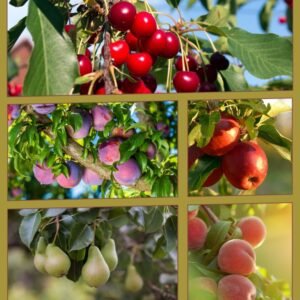Fruit trees are valuable additions to any garden, bringing beauty, colour, and the joy of seasonal harvests. To keep them flourishing and productive, regular pruning is a must. Pruning is not just about removing branches but about supporting the overall health, structure, and fruit yield of the tree.
What Is Fruit Tree Pruning?
Fruit tree pruning involves selectively removing branches to enhance the tree’s structure, health, and fruit production. It’s a vital process that improves sunlight exposure, boosts air circulation, and reduces the risk of pests and diseases.
Proper pruning techniques play a significant role in the long-term health of the tree. By carefully removing overcrowded or damaged branches, the tree focuses its energy on producing higher-quality fruit. According to the People’s Trust for Endangered Species (PTES), pruning encourages dormant buds in old wood to produce vegetative growth, which becomes the next young fruiting wood.
Did you know? Fruit trees that are regularly pruned can increase their fruit production by up to 20% each year! (Source: PTES)
Benefits of Pruning Your Fruit Trees
Pruning offers numerous advantages for your trees, your garden, and your harvest. Here are five key benefits:
- Increased Fruit Yield: Regular pruning stimulates the growth of strong, fruit-bearing branches, leading to better-quality fruit. (Source: PTES)
- Disease Prevention: Thinning out overgrown areas reduces moisture buildup, a key cause of fungal diseases such as apple scab or canker. (Source: RHS)
- Enhanced Garden Aesthetics: Pruned trees not only stay healthy but also add a structured charm to your garden.
- Simplified Maintenance: Smaller, well-managed trees are easier to harvest, inspect, and care for.
- Extended Tree Longevity: Pruning helps your fruit trees live longer by maintaining their vitality.
What Types of Fruit Trees Benefit from Pruning?
Certain fruit trees thrive when pruned correctly, and many common varieties benefit from professional care. Some of the most popular fruit trees that require pruning include:

- Apple Trees (Malus domestica): Regular pruning helps to maintain shape, promote better fruiting, and prevent disease.
- Plum Trees (Prunus domestica): Pruning plums not only improves air circulation but also encourages higher yields.
- Cherry Trees (Prunus avium): Like plums, cherries benefit from summer pruning to reduce the risk of silver leaf disease.
- Pear Trees (Pyrus): Pruning pears ensures they have a strong structure for bearing fruit and helps maintain their shape.
- Peach Trees (Prunus persica): These require careful pruning to encourage robust fruiting and prevent excessive growth.
When Should You Prune Your Fruit Trees?
Timing is everything when it comes to pruning. For most fruit trees, the best time to prune is late winter or early spring, during dormancy. Pruning during this time allows the tree to heal before the growing season begins. However, trees like cherries and plums benefit from summer pruning, as it helps prevent diseases such as silver leaf.
A good rule of thumb is to prune fruit trees annually. Neglecting this process for several years can lead to overcrowded branches, reduced fruit yield, and higher susceptibility to disease.
Pro Tip: If you’re uncertain about the best time to prune, consult a professional arborist to assess your tree and recommend the ideal schedule. (Source: RHS)
Why Choose Professional Pruning Services?
Pruning requires skill and experience to ensure the cuts are made correctly without causing harm to the tree. Professionals like those at Tiptop Tree Services bring years of expertise in pruning fruit trees across Didcot, Oxfordshire, and Berkshire. Whether you’re managing a small orchard or a single apple tree, our team ensures sustainable, professional care tailored to your garden’s needs.
FAQs About Pruning
Q. Can I prune my fruit trees myself?
A. While light maintenance is manageable, professional pruning ensures precise cuts and avoids damaging the tree. Improper pruning can sometimes lead to long-term harm, like weak branch structures or increased susceptibility to disease.
Q. How often should fruit trees be pruned?
A. Generally, once a year is sufficient, though some vigorous trees might require a mid-season trim to manage overgrowth.
Q. Will pruning drastically reduce my tree’s size?
A. No. Pruning aims to balance the tree’s size, shape, and productivity. A professional approach ensures that only the necessary cuts are made.
Did you know
That fruit trees like apples and cherries have been cultivated in the UK for over 2,000 years? Historically, gardeners pruned trees to enhance sunlight capture and improve yields—a technique still practised today. Studies show that well-pruned trees can produce up to 40% more fruit over their lifespan compared to neglected trees.
Get a Pruning Plan That Works for You

Your fruit trees deserve the best care to thrive year after year. Whether you’re in Didcot, Oxfordshire, or Berkshire, TipTop Tree Services is here to help. From pruning apple and cherry trees to managing entire orchards, we bring out the best in your garden.
Want to Learn About Winter Wonderland Tree Care?
Check out our latest blog for expert tips on how to protect your trees during the colder months! From pruning and mulching to pest prevention, we’ve got you covered. Read the Full Blog Here
Want more tips and expert advice? Follow us on Facebook to stay updated on all things tree care. Don’t forget to read our Tree Pruning and watch out for new posts coming soon!
Book now for a professional pruning service! Call us today or visit our website to schedule a consultation and keep your garden thriving.
📞 Call us today for a free tree assessment: 07392001837
🌐 Visit our website: https://tiptoptreeandgroundcare.co.uk
Let’s safeguard your trees and property this season!
References

